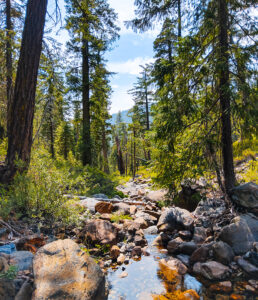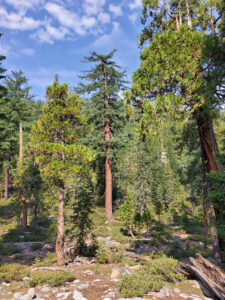
Summer 2023
Saving the Source: Conserving 11,000 acres of the Trinity River Headwaters
PFT’s goal of conserving the core source watersheds of California has moved another key step forward. Our project to acquire and conserve 11,000 acres at the very top of the Trinity River moved closer to completion this past month with the Sierra Nevada Conservancy making a significant grant of $1.4M to PFT to help protect this invaluable source watershed.
Building on a major $2M federal grant secured with the help of Congressman Jared Huffman, PFT hopes to complete this project’s funding by early 2024.
In an innovative partnership, PFT plans to acquire the Trinity Headwaters from Acer Klamath Forests, a willing private landowner who recently acquired it from MichiCal, the previous timberland owner with whom PFT was working. We will then conserve it with a working forest conservation easement and convey it to the Watershed Research and Training Center (WRTC) to be managed for the benefit of both ecological and human communities.
The property is characterized by rare biodiversity (supporting over 230 species, a number of which are endangered, highly vulnerable, and endemic) and will be a major refuge for wildlife as climate change advances. Protecting this watershed is critical for the entire state’s water supply and its biodiversity—meeting two key state goals for water security and 30×30 (conserving 30% of the state’s lands and coastal waters by 2030). And it forms a linchpin of PFT’s strategy to create an integrated network of conserved forest watersheds that feed the Sacramento River and are critical for the state’s water security.
For millennia, the Trinity River sustained the Hoopa and Yurok people, as well as a myriad of fish, plants, and wildlife. In turn, these people honored the river, deriving their identity from it, as the Trinity River was originally named the Hoopa, or Hupa, by the Yurok people. While European Americans have treated this river quite differently, mining it extensively since the 1800s, logging its watersheds, and damming it for water to grow the state’s irrigated agricultural economy, this project aims to ensure the Trinity River headwaters be restored and flow for millennia to come.

The Trinity Headwaters has rare pristine streams…

…and intact old growth habitats.
More in this Issue of ForestLife
- President’s Letter: Aren’t we there yet?
- Managing for Climate Resilience on Mount Ashland Demonstration Forest
- Harnessing the Power of Nature to Address Climate Change
- Donor Profile: Barbara and Mark Daugherty
- Beyond the Trees: Our New Award-Winning Film
- Celebrating 30 Years and Forest Wildlife: Forest Fete 2023
